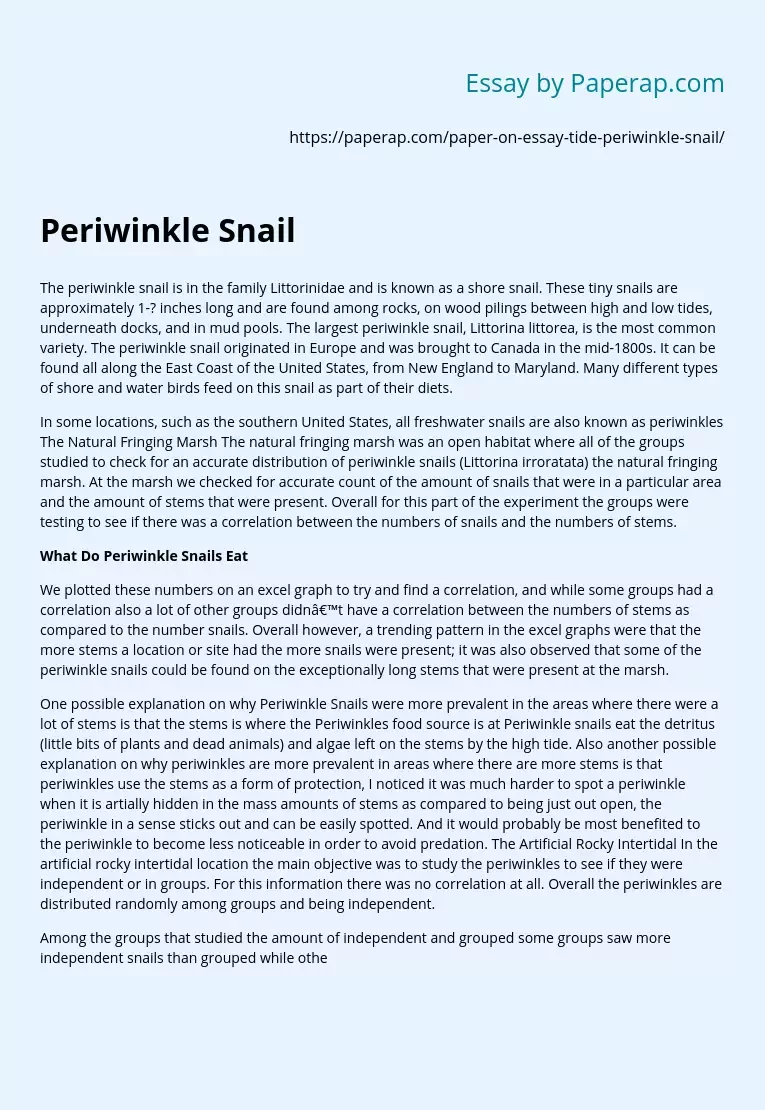Periwinkle Snail
The periwinkle snail is in the family Littorinidae and is known as a shore snail. These tiny snails are approximately 1-? inches long and are found among rocks, on wood pilings between high and low tides, underneath docks, and in mud pools. The largest periwinkle snail, Littorina littorea, is the most common variety. The periwinkle snail originated in Europe and was brought to Canada in the mid-1800s. It can be found all along the East Coast of the United States, from New England to Maryland.
Many different types of shore and water birds feed on this snail as part of their diets.
In some locations, such as the southern United States, all freshwater snails are also known as periwinkles The Natural Fringing Marsh The natural fringing marsh was an open habitat where all of the groups studied to check for an accurate distribution of periwinkle snails (Littorina irroratata) the natural fringing marsh. At the marsh we checked for accurate count of the amount of snails that were in a particular area and the amount of stems that were present.
Overall for this part of the experiment the groups were testing to see if there was a correlation between the numbers of snails and the numbers of stems.
What Do Periwinkle Snails Eat
We plotted these numbers on an excel graph to try and find a correlation, and while some groups had a correlation also a lot of other groups didn’t have a correlation between the numbers of stems as compared to the number snails.
Overall however, a trending pattern in the excel graphs were that the more stems a location or site had the more snails were present; it was also observed that some of the periwinkle snails could be found on the exceptionally long stems that were present at the marsh.
One possible explanation on why Periwinkle Snails were more prevalent in the areas where there were a lot of stems is that the stems is where the Periwinkles food source is at Periwinkle snails eat the detritus (little bits of plants and dead animals) and algae left on the stems by the high tide. Also another possible explanation on why periwinkles are more prevalent in areas where there are more stems is that periwinkles use the stems as a form of protection, I noticed it was much harder to spot a periwinkle when it is artially hidden in the mass amounts of stems as compared to being just out open, the periwinkle in a sense sticks out and can be easily spotted. And it would probably be most benefited to the periwinkle to become less noticeable in order to avoid predation. The Artificial Rocky Intertidal In the artificial rocky intertidal location the main objective was to study the periwinkles to see if they were independent or in groups. For this information there was no correlation at all. Overall the periwinkles are distributed randomly among groups and being independent.
Among the groups that studied the amount of independent and grouped some groups saw more independent snails than grouped while other groups saw more grouped snails than independent. There was even one group who saw an even amount of grouped snails as independent snails (15 independent; 15 grouped). So, overall when it comes to this data there is no clear influences on whether periwinkles are grouped are independently distributed.
Sources BRENCHLEY, G. A. , CARLTON, J. T. COMPETITIVE DISPLACEMENT OF NATIVE MUD SNAILS BY INTRODUCED PERIWINKLES IN THE NEW ENGLAND INTERTIDAL ZONE Biol Bull 1983 165: 543-558
Periwinkle Snail. (2019, Dec 05). Retrieved from https://paperap.com/paper-on-essay-tide-periwinkle-snail/

